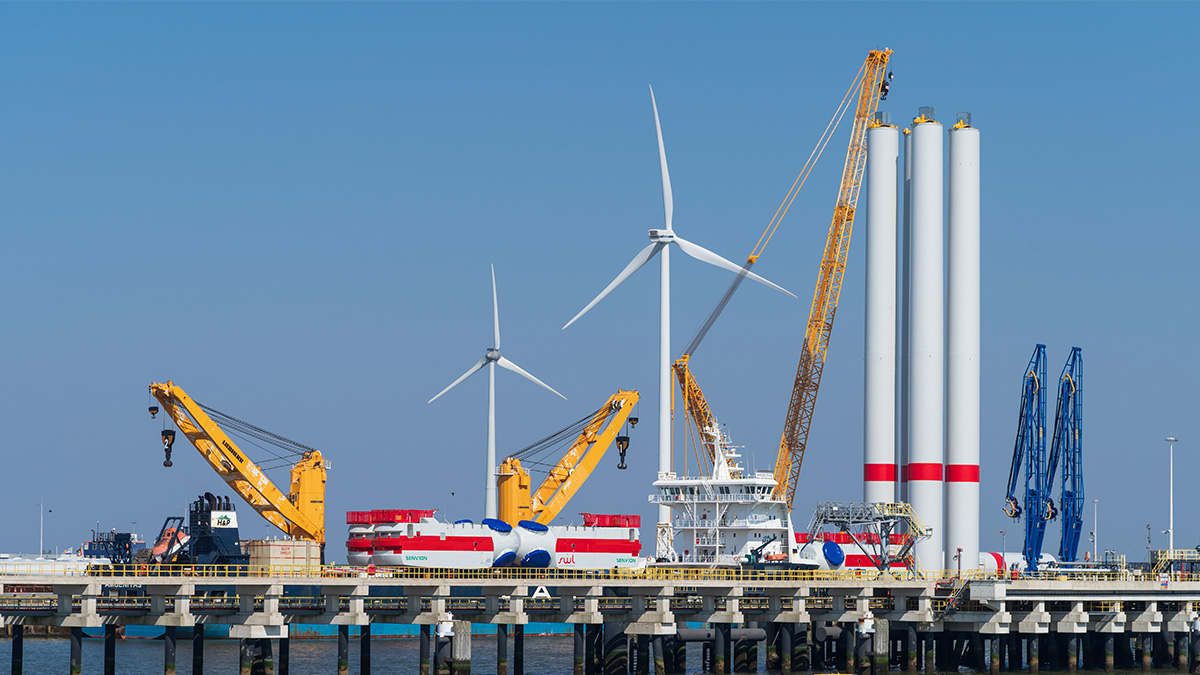Europe aims to increase its offshore wind capacity to 84 GW by 2030, but one of the most important challenges is the lack of investment in shipbuilding and port infrastructure
Brussels, August 2025— Europe is facing a shortfall in offshore wind investment, according to a new report by IndEurope News. With just five years to go to meet its 2030 energy targets, Europe offshore wind investment needs an additional €2.4 billion in funding to ensure its offshore wind infrastructure can grow in time. Without this investment, Europe will fall behind in its clean energy transition.
Table of Contents
Europe needs urgent action to meet offshore wind targets
Europe currently has 36.6 gigawatts (GW) of installed offshore wind capacity. To meet climate targets and energy security commitments, this figure needs to rise to 84 GW by 2030. Achieving this target depends on the continent installing at least 10 GW of offshore wind capacity annually, which is expected to increase to 15 GW per year after 2030.
While the installation rate is currently on track, supporting infrastructure, including ports and ships, is not developing fast enough. It is understood that significant capacity shortfalls could hinder the deployment of offshore wind projects in the future.
Marine infrastructure plays a central role
The offshore wind supply chain is heavily dependent on Europe’s maritime infrastructure. In the last three years, €6.7 billion has been invested in port upgrades and ship procurement. Analysts warn an additional €6.4 billion is needed, and €2.4 billion in the short term to meet the 2030 target.
This infrastructure is needed for building, installing, and maintaining wind turbines, so without immediate investment in this area, the supply chain may not be able to handle the volume of installations needed to stay on track.
Read more: https://windnewstoday.com/pd-ports-aims-200m-offshore-wind-hub-teesport/: Europe Needs More €2.4bn Investment for 2030 Offshore Wind Goals—ReportEU ports strategy aims to fill infrastructure gaps
The European Commission is developing a new EU-wide ports strategy aimed at supporting the offshore wind sector. Ports are crucial for the industry. They act as logistical hubs for transporting turbines and components, act as maintenance bases and provide the space needed to assemble large structures—especially for floating offshore wind.
Strategic importance of ports for offshore wind
Over the past three years, €4.4 billion has been invested in port infrastructure across Europe, yet the report finds that an additional €2.4 billion is urgently needed to upgrade facilities and expand port capacity, as ports play a key role in supporting local wind energy supply chains and delivering efficient projects across the continent.
Policy measures proposed in the EU Ports Strategy
The Ports Strategy is expected to recommend three key actions. Firstly, the European Investment Bank could be involved in increasing funding allocations through programs such as the EU Connecting Europe Facility and supporting strategic projects. Secondly, the Commission is likely to simplify permitting procedures, as it can currently take up to 10 years to approve port expansions. Finally, the strategy could include an EU-wide map of port capacity and plans to match them with the demand for offshore wind deployment in member states.
Shipbuilding and ship investment are barriers.
In the case of offshore wind, there was talk of ports but in addition to ports, Europe needs to make significant investments in its offshore wind fleet. Why ports? Because currently, around 80 ships are used across Europe to install turbines and transport workers. The emergence of larger turbines over 15 MW requires a new generation of ships with more advanced capabilities.
Technological innovation of ships is needed
In the last three years, Europe has already invested around €2.3 billion in offshore wind ships. Despite this progress, an additional €4 billion is needed to install larger and more technologically advanced turbines, many of which are not capable of handling the weight and complexity of the new models.
Reducing emissions from marine activities
Marine activities currently contribute up to 20% of the total life cycle emissions of an offshore wind project. Decarbonizing this sector is crucial. The EU Maritime Industrial Strategy is expected to promote clean fuels such as hydrogen, ammonia, and electricity while supporting the refitting of older ships or the construction of new zero-emission ships.
How Europe’s Offshore Wind Future Hinges on Strategic Europe Offshore Wind Investment
Europe’s offshore wind future largely depends on timely investment. Its ability to meet its offshore wind targets depends on swift and coordinated action. A well-funded port strategy and a forward-looking maritime industry strategy can ensure that infrastructure, permitting, and innovation are developed in line with demand.
Without investment, the European Union could fail to achieve its 2030 offshore wind goals. It clearly said that it risks losing its global leadership in renewable energy. Though the window for action narrows, decisions taken in the coming months will fix the future of Europe’s clean energy landscape.
Key points:
- More than €4.4 billion has been invested in ports.
- Ports supply, store, assemble, and maintain wind equipment.
- Floating offshore wind infrastructure to be integrated into port areas
- Europe to generate 10 GW of electricity per year by 2030 and 15 GW later
- A €2.4 billion shortfall needs to be urgently filled.
- Ports and ships are out of the question for offshore wind to succeed.
- The strategic move will determine Europe’s energy security and competitiveness for decades to come.
In the Bottom
If the EU is serious about leading the way in offshore wind, it needs to match ambition with investment. The proposed EU Port Strategy and Maritime Industry Strategy offer a golden opportunity to close the Europe offshore wind investment of €2.4 billion and strengthen Europe’s journey towards a cleaner, more resilient energy system.

71i5ro
h4vcrw